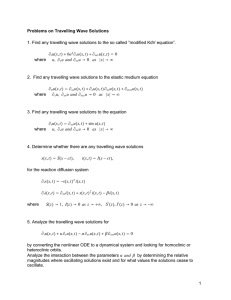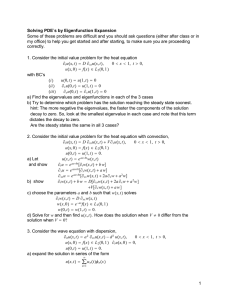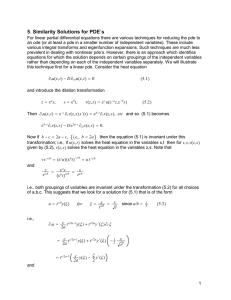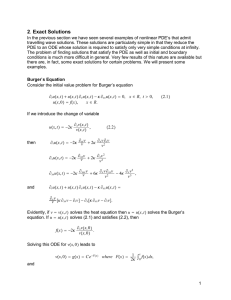Higher Order Nonlinear PDE 1
advertisement
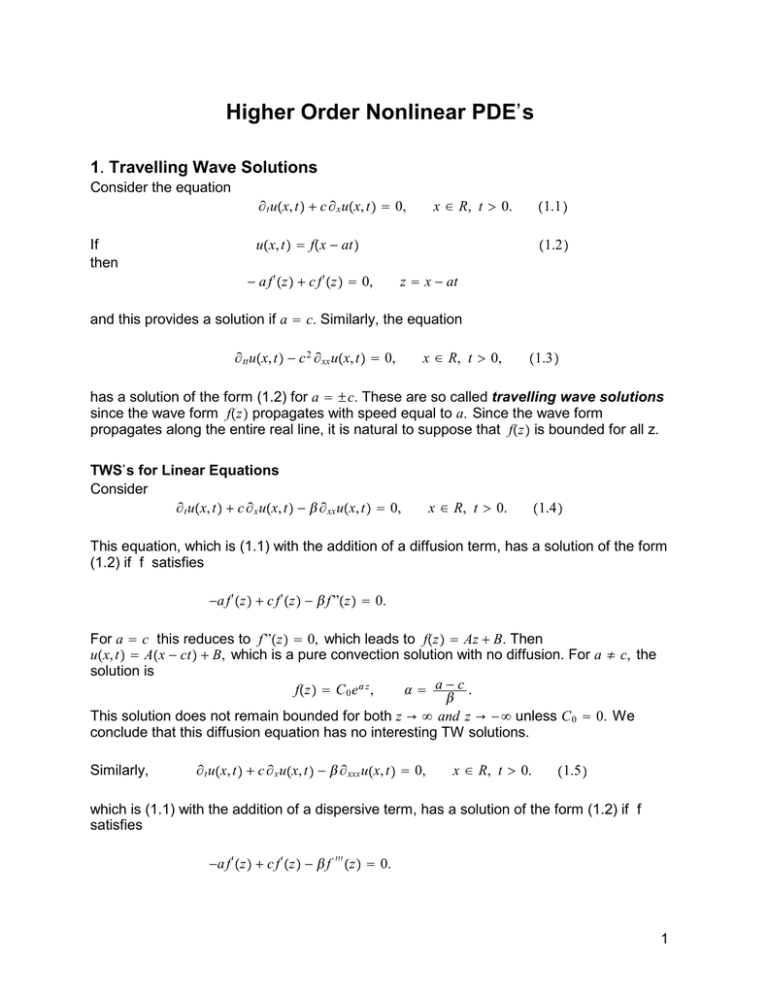
Higher Order Nonlinear PDE’s 1. Travelling Wave Solutions Consider the equation / t uÝx, tÞ + c / x uÝx, tÞ = 0, If then x 5 R, t > 0. Ý1.1Þ uÝx, tÞ = fÝx ? atÞ ? a f v ÝzÞ + c f v ÝzÞ = 0, Ý1.2Þ z = x ? at and this provides a solution if a = c. Similarly, the equation / tt uÝx, tÞ ? c 2 / xx uÝx, tÞ = 0, x 5 R, t > 0, Ý1.3Þ has a solution of the form (1.2) for a = ± c. These are so called travelling wave solutions since the wave form fÝzÞ propagates with speed equal to a. Since the wave form propagates along the entire real line, it is natural to suppose that fÝzÞ is bounded for all z. TWS’s for Linear Equations Consider / t uÝx, tÞ + c / x uÝx, tÞ ? K / xx uÝx, tÞ = 0, x 5 R, t > 0. Ý1.4Þ This equation, which is (1.1) with the addition of a diffusion term, has a solution of the form (1.2) if f satisfies ?a f v ÝzÞ + c f v ÝzÞ ? K f ”ÝzÞ = 0. For a = c this reduces to f ”ÝzÞ = 0, which leads to fÝzÞ = Az + B. Then uÝx, tÞ = AÝx ? ctÞ + B, which is a pure convection solution with no diffusion. For a ® c, the solution is J = a?c. fÝzÞ = C 0 e J z , K This solution does not remain bounded for both z ¸ K and z ¸ ? K unless C 0 = 0. We conclude that this diffusion equation has no interesting TW solutions. Similarly, / t uÝx, tÞ + c / x uÝx, tÞ ? K / xxx uÝx, tÞ = 0, x 5 R, t > 0. Ý1.5Þ which is (1.1) with the addition of a dispersive term, has a solution of the form (1.2) if f satisfies ?a f v ÝzÞ + c f v ÝzÞ ? K f vvv ÝzÞ = 0. 1 For a = c this reduces to f vvv ÝzÞ = 0, which leads to fÝzÞ = Az 2 + Bz + C, which is again a pure convection solution with no dispersion. For a ® c, the solution is for J2 = a ? c . fÝzÞ = C 0 sinh Jz + C 1 cosh Jz, K This solution does not remain bounded for both z ¸ K and z ¸ ? K unless C 0 = C 1 = 0, and we conclude that the dispersion equation has no interesting TW solutions. In general, only hyperbolic linear PDE’s will have interesting TW solutions. However, for nonlinear equations the effects of the nonlinear term and the higher order terms interact to produce interesting results. We will begin by constructing simple solutions for several examples of quasilinear equations of order higher than one. Burger’s Equation (with Viscosity) Consider the equation / t uÝx, tÞ + u / x uÝx, tÞ ? K / xx uÝx, tÞ = 0 produces shocks Ý1.6Þ smooths out the solution We recall from previous results that the lower order part of the equation can lead to shock type solutions while the higher order term has the effect of smoothing out the initial data to produce a very smooth solution. We will now examine the interaction of these two competing effects. Assume a solution of the form (1.2). Then f must satisfy i.e., Then ?a f v ÝzÞ + fÝzÞ f v ÝzÞ ? K f ”ÝzÞ = 0, K f ”ÝzÞ = d dz K f v ÝzÞ = or 1 2 1 2 fÝzÞ 2 ? a fÝzÞ . fÝzÞ 2 ? a fÝzÞ + C 0 , f vÝzÞ = 1 ßf 2 ? 2af + C 1 à = 1 Ýf ? f 1 ÞÝf ? f 2 Þ. 2K 2K Here f 1 + f 2 = 2a and f 1 f 2 = C 1 so f 1,2 = a ± Note that a2 ? C1 , f v ÝzÞ = 0 f v ÝzÞ < 0 f v ÝzÞ > 0 0 < C1 < a2. if f = f 1 or f = f 2 if f 1 < f < f 2 , if f < f 1 or f > f 2 . This leads to the following scenario for f versus z, 2 Figure 1 It is evident that the equation f vÝzÞ = 1 Ýf ? f 1 ÞÝf ? f 2 Þ 2K has an unstable critical point at f = f 2 and a stable critical point at f = f 1 . If we look at a phase plane portrait for this equation Figure 2 where f v is plotted against f , we see that the portion of the graph in Figure 1 that is contained between the horizontal lines f = f 1 and f = f 2 corresponds to the heteroclinic orbit shown in Figure 2, joining f 2 to f 1 . In this example, an explicit analytical solution for fÝzÞ is possible. The equation implies X df = 1 X dz 2K Ýf ? f 1 ÞÝf ? f 2 Þ leading to ?kz fÝzÞ = f 1 + f 2 e?kz 1+e Clearly for k = f 2 ? f 1 > 0. 2K Ý1.7Þ fÝzÞ ¸ f 1 as z ¸ + K fÝzÞ ¸ f 2 as z ¸ ? K fÝ0Þ = 12 Ýf 1 + f 2 Þ. 3 If we denote uÝx, t; KÞ = fÝx ? atÞ for f given by (1.7), with a = 12 Ýf 1 + f 2 Þ = fÝ0Þ, then as K ¸ 0, uÝx, t; KÞ tends to the shock solution of the Riemann problem / t uÝx, tÞ + u / x uÝx, tÞ = 0, uÝx, 0Þ = f 2 if x < 0 f 1 if x > 0 The following figure illustrates how uÝx, t; KÞ approaches the shock solution as K decreases. Evidently for large K the diffusion term overpowers the nonlinear term and the solution is smooth but as K decreases, the nonlinear term begins to take over, inducing a steepening front which becomes a shock discontinuity when K reaches zero. Beta = 5, .5, .05 Note that the speed of the travelling wave, a = 12 Ýf 1 + f 2 Þ = fÝ0Þ, is the propagation speed associated with the shock solution of the Riemann problem. It is an interesting difference between the linear and nonlinear problems that the wave speed for the linear equations (1.1) and (1.3) is determined by a coefficient in the equation while the wave speed for the nonlinear equation (1.6) is determined by the initial state. We have seen previously for the more general version of equation (1.6), / t uÝx, tÞ + / x FÝuÝx, tÞÞ ? K / xx uÝx, tÞ = 0 Ý1.8Þ where F ”ÝuÞ > 0, that the PDE has a solution of the form (1.2) if f satisfies f v ÝzÞ = 1 ßFÝfÝzÞÞ ? afÝzÞ + C 0 à. K For a TWS we must require that f v ÝzÞ ¸ 0, as | z| ¸ K and hence a= FÝfÝ+KÞÞ ? FÝfÝ?KÞÞ FÝf 2 Þ ? FÝf 1 Þ = . f2 ? f1 fÝ+KÞ ? fÝ?KÞ We recognize the speed a of the travelling wave as the shock speed associated with the shock solution of the Riemann problem for the equation, / t uÝx, tÞ + / x FÝuÝx, tÞÞ = 0. Here, as for (1.6), the wave speed is determined by the initial state. The assumption, F ”ÝuÞ > 0, implies that there are two values z = f 1 , f 2 where f v ÝzÞ = 0. This is evident in the following figure where we have plotted 4 G 1 ÝfÞ = FÝfÝzÞÞ + C 0 and G 2 ÝfÞ = afÝzÞ versus f on the same axes, It is evident that f v ÝzÞ = 1 ßG 1 ÝfÝzÞÞ ? G 2 ÝfÝzÞÞà < 0 for f 1 < f < f 2 and f v ÝzÞ > 0 otherwise. K This implies the existence of a stable critical point at f = f 1 and an unstable critical point at f = f 2 and the TWS for the PDE corresponds to the heteroclinic orbit joining the unstable point to the stable critical point. The KdV Equation If we replace the diffusive term in (1.6) by a dispersive term, we obtain / t uÝx, tÞ + u / x uÝx, tÞ + K / xxx uÝx, tÞ = 0 Ý1.9Þ If we assume a solution of the form (1.2) then i.e., and ?a f v ÝzÞ + fÝzÞ f v ÝzÞ + K f vvv ÝzÞ = 0 d ?a fÝzÞ + dz ?a fÝzÞ + 1 2 1 2 fÝzÞ 2 + K f ”ÝzÞ = 0, fÝzÞ 2 + K f ”ÝzÞ = C 0 . Now we impose on f the conditions fÝzÞ, f v ÝzÞ, and f ”ÝzÞ all tend to 0 as | z| ¸ K. Under these conditions a solution of the form (1.2) is called a solitary wave. Then ?a fÝzÞ + 1 2 fÝzÞ 2 + K f ”ÝzÞ = 0, Ý1.10Þ and ?a fÝzÞ f v ÝzÞ + 1 2 fÝzÞ 2 f v ÝzÞ + K f ”ÝzÞ f v ÝzÞ = 0. 5 i.e., d ? dz ? Then 1 2 1 2 a fÝzÞ 2 + a fÝzÞ 2 + 1 6 1 6 fÝzÞ 3 + fÝzÞ 3 + 1 2 1 2 K f v ÝzÞ 2 = 0. K f v ÝzÞ 2 = C 1 = 0 where the solitary wave assumptions have been applied once more to conclude C 1 = 0. Then 3K f v ÝzÞ 2 = 3a fÝzÞ 2 ? fÝzÞ 3 , and f v ÝzÞ = X Then leads to 1 fÝzÞ 3a ? fÝzÞ . 3K df = f 3a ? f 1 X dz 3K fÝzÞ = 3a Sech 2 a Ýz ? z 0 Þ 4K and uÝx, tÞ = fÝx ? atÞ = 3a Sech 2 a Ýx ? at ? z 0 Þ . 4K One of the most novel features of this solution is that the wave speed, a, is proportional to the wave amplitude which equals 3a. u(x,0) for a=4 If we let u = f and v = f in the equation (1.10), v ?a fÝzÞ + 1 2 fÝzÞ 2 + K f ”ÝzÞ = 0, then uv = v and v v = 1 uÝ2a ? uÞ. 2K This 2-dimensional dynamical system has critical points at Ý0, 0Þ and Ý2a, 0Þ. The Jacobian of the system is 6 JÝu, vÞ = 0 a?u K 1 . 0 a and JÝ2a, 0Þ has eigenvalues V = ± i a , so that K K Ý0, 0Þ is a saddle point and Ý2a, 0Þ is a center. This leads to the following phase plane portrait Then JÝ0, 0Þ has eigenvalues V = ± The closed orbits represent periodic solutions to the first order dynamical system. The homoclinic orbit that begins and ends at the origin represents the solitary wave solution to the equation (1.10). The curves outside the homoclinic orbit are associated with unbounded solutions to the equation. Now suppose we release the solitary wave assumptions and try to find other types of travelling wave solutions for the KdV equation. Returning to the equation ? a fÝzÞ + 1 2 fÝzÞ 2 + K f ”ÝzÞ = C 0 we do not suppose C 0 = 0, and we write C 0 f v ÝzÞ = ?a fÝzÞ f v ÝzÞ + 1 2 fÝzÞ 2 f v ÝzÞ + K f ”ÝzÞ f v ÝzÞ K = d ? a fÝzÞ 2 + 1 fÝzÞ 3 + f v ÝzÞ 2 . 2 6 2 dz Then or 3K f v ÝzÞ 2 = ?fÝzÞ 3 + 3a fÝzÞ 2 + C 0 fÝzÞ + C 1 , 7 f v ÝzÞ = 1 Ýf ? f 1 ÞÝf ? f 2 ÞÝf 3 ? fÞ = ± FÝfÞ . 3K Now there are several cases to consider: (a) F(f) has distinct, real roots f 1 < f 2 < f 3 (b) F(f) has one real root f 3 5 R, f 1,2 = J ± i b (c) F has a double real root f1 = f2 < f3 (d) F has a triple real root f 1 = f 2 = f 3 . Now, real solutions for f v ÝzÞ = ± FÝfÞ exist only when FÝfÞ ³ 0. In each of the 4 cases then this leads to real solutions for the following ranges of f values. (a) The darkened intervals indicate that solutions exist for f < f 1 and f 2 < f < f 3 : (b) Solution exists for f < f 3 : (c) Solution exists for f < f 1 or f < f 3 8 (d) Solution exists for f < f 1 Consider, for example, case (b). At some point z 0 where fÝz 0 Þ < f 3 , either we have f v Ýz 0 Þ < 0, in which case fÝzÞ continues to decrease for all z > z 0 so that fÝzÞ must tend to minus infinity as z ¸ +K, or else we have f v Ýz 0 Þ > 0, in which case fÝzÞ increases until it reaches f 3 and then it stops because f v Ýz 3 Þ = 0. In this case it must be that fÝzÞ must tend to minus infinity as z ¸ ?K. Then it follows that in case (b), the solutions are either constant or else they are unbounded. The same result occurs in case (d), in case (c) when f ² f 1 , and in the part of the solution interval in case (a) when f ² f 1 . On the other hand, the part of case (c) where f 1 = f 2 < f < f 3 corresponds to the solitary wave solution, since f satisfies f v ÝzÞ = 1 fÝzÞ f 3 ? fÝzÞ , where we chose f 1 = f 2 = 0. 3K There remains the part of case (a) where f 2 < f < f 3 , and we have 3K f v ÝzÞ 2 = FÝfÝzÞÞ, or differentiating, 6K f v ÝzÞ f”ÝzÞ = F v ÝfÝzÞÞ f v ÝzÞ. Then f”ÝzÞ = 1 F v ÝfÝzÞÞ 6K and we see from the sketch that at a point z 1 where fÝz 1 Þ = f 2 , we have F v Ýf 2 Þ > 0 so that f ”Ýz 1 Þ > 0 and f 2 is a min for fÝzÞ 9 z 2 where fÝz 2 Þ = f 3 , we have F v Ýf 3 Þ < 0 so that f ”Ýz 1 Þ < 0 and f 3 is a max for fÝzÞ. Then the solution fÝzÞ must oscillate between the values f 2 and f 3 . This periodic solution has been seen to exist in a qualitative sense. In order to discover quantitative information about it, we must integrate the differential equation for fÝzÞ which requires use of elliptic functions. The solutions in this case are referred to as cnoidal waves. The Sine Gordon Equation Consider a solution of the form (1.2) for the equation / tt uÝx, tÞ ? / xx uÝx, tÞ = sin uÝx, tÞ Ý1.11Þ a 2 f ”ÝzÞ ? f ”ÝzÞ = sinÝfÝzÞÞ, Then or, f ”ÝzÞ = A sinÝfÝzÞÞ where A= 1 . a ?1 2 We can rewrite this as or and f ”ÝzÞ f v ÝzÞ = A sinÝfÝzÞÞ f v ÝzÞ d dz 1 2 f v ÝzÞ 2 = ?A d cosÝfÝzÞÞ dz f v ÝzÞ 2 = C 1 ? 2A cosÝfÝzÞÞ, f v ÝzÞ = C 1 ? 2A cosÝfÝzÞÞ . Integration of this last equation is possible but leads to elliptic functions. Instead, a qualitative examination of the solution can be carried out by letting 10 f v ÝzÞ = gÝzÞ, g v ÝzÞ = sinÝfÝzÞÞ . a2 ? 1 Then this dynamical system (whose equations are formally the same as the pendulum equations) has singular points at Ýn^, 0Þ and it is easy to show that when a 2 > 1 the even integer multiples of ^ are saddle points while the odd integer multiples of ^ are centers. When a 2 < 1 the odd integer multiples of ^ are saddle points and the even integer multiples of ^ are centers. This leads to the usual phase plane picture associated with the pendulum. The figure below shows the phase plane portrait for a = .1. Evidently, the heteroclinic orbit joining the saddle at Ý?^, 0Þ to the saddle at Ý^, 0Þ corresponds to a travelling wave solution for the Sine-Gordon equation where the shape of the wave varies slightly as the wave speed a varies, TWS’s exist for every wave speed a 2 < 1. The closed orbits inside the separatrix correspond to periodic solutions. When a 2 > 1, there are saddle points at 0 and 2^ and we get TWS’s for every wave speed a 2 > 1 as well, but connecting u = 0 to u = 2^ instead of connecting u = ?^ to u = ^. The Nonlinear Schrodinger Equation Consider the equation i / t uÝx, tÞ + / xx uÝx, tÞ + u |u| 2 = 0, Ý1.12Þ where u is complex valued. This equation arises in applications where it is expressed relative to a frame of reference that is moving with the group velocity of a travelling wave. Therefore the TW solution of this equation appears as a standing wave. That is, we look for a solution of the form, 11 uÝx, tÞ = fÝxÞ e iK t . Then or ?K fÝxÞ + f ”ÝxÞ + fÝxÞ 3 = 0, f ”ÝxÞ = fÝxÞ K ? fÝxÞ 2 . Since explicit integration leads to elliptic functions, instead we let f v ÝxÞ = gÝxÞ, and g v ÝxÞ = fÝxÞ K ? fÝxÞ 2 . This system has critical points at Ý0, 0Þ and ± K , 0 . It is straightforward to show that the origin is a saddle point while the other two critical points are centers. The closed curves in the phase plane portrait are periodic solutions while the separatrix is a homoclinic orbit corresponding to a solitary wave that begins with f = f v = 0 at x = ?K, it increases to a point of maximum intensity (where f v = 0, f > 0) and then decreases to f = f v = 0 at x = +K. A Diffusion-Dispersion Example Consider the example / t uÝx, tÞ + u / x uÝx, tÞ ? J / xx uÝx, tÞ + K / xxx uÝx, tÞ = 0 where J > 0. If we suppose uÝx, tÞ = vÝx ? ctÞ then ?cv v ÝzÞ + vÝzÞv v ÝzÞ ? J v”ÝzÞ + K v vvv ÝzÞ = 0. 12 Integrating once leads to C 0 ? c vÝzÞ + 1 2 vÝzÞ 2 ? J v v ÝzÞ + K v”ÝzÞ = 0. If we suppose v v ÝzÞ and v”ÝzÞ ¸ 0 as | z| ¸ K then vÝzÞ tends to a constant value as z tends to infinity. However, vÝzÞ need not tend to the same constant value in both directions. Suppose, then that vÝzÞ ¸ 0 as z ¸ K, and vÝzÞ ¸ V 0 as z ¸ ?K. Then C 0 ? c vÝKÞ + C 0 ? c vÝ?KÞ + 1 2 vÝKÞ 2 ? J v v ÝKÞ + K v”ÝKÞ = C 0 = 0 1 2 vÝ?KÞ 2 ? J v v Ý?KÞ + K v”Ý?KÞ = C 0 ? c V 0 + 1 2 V 20 = 0. Evidently, these conditions at infinity can hold only if C 0 = 0 and c = 12 V 0 ; that is, the speed of the travelling wave solution is determined by the ”initial value” V 0 . In this case the wave form of the TWS, vÝzÞ satisfies, K v”ÝzÞ = c vÝzÞ ? 1 2 vÝzÞ 2 + J v v ÝzÞ. Treating this as a dynamical system by letting UÝzÞ = vÝzÞ, VÝzÞ = v v ÝzÞ leads to d dt U V = V 1U c? 1U + JV K K 2 This system has a saddle point at Ý2c, 0Þ and a stable node or stable focus at Ý0, 0Þ depending on whether J 2 ? 4cK is positive or negative respectively. In either case there is a heteroclinic orbit joining the saddle point to the origin. In the case that the origin is a stable node, the travelling wave form decreases monotonically to zero. In the case that the origin is a stable focus, the function UÝzÞ assumes both positive and negative values as z tends to plus infinity. We can give a physical motivation for this behavior as follows. If we write K v”ÝzÞ = c vÝzÞ ? 1 2 vÝzÞ 2 + J v v ÝzÞ = ? d dz 1 6 v3 ? 1 2 cv 2 + Jv v ÝzÞ then we can interpret this as the equation for the motion of a nonlinear spring with potential function PÝvÞ = 1 6 v3 ? 1 2 cv 2 and viscous damping equal to Jv v ÝzÞ. Since J > 0 the parameter z must be interpreted as negative time. If the spring state is given by v = v v = 0 at t = ?K Ýi.e., z = +KÞ then the particle will tend to the state v = 2c, v v = v” = 0 as t ¸ K. For J small relative to K the spring will execute oscillations on the way to the steady state, whereas if J is large relative to K, then the spring does not oscillate as it travels to the steady state. In the context of the nonlinear spring, these two scenarios are called the underdamped and overdamped cases, respectively. The following figures illustrate 13 The path to steady state A Reaction-Diffusion Example We will consider now an example in which a travelling wave occurs for precisely one value of the wave speed. The equation / t uÝx, tÞ ? / xx uÝx, tÞ = fÝuÝx, tÞÞ Ý1.13Þ where 14 fÝ0Þ = fÝaÞ = fÝ1Þ = 0 fÝxÞ < 0, 0 < x < a, fÝxÞ > 0, a < x < 1, v v f vÝ0Þ < 0, f ÝaÞ > 0, f Ý1Þ < 0 i.e., 1 X 0 fÝsÞds > 0, is called a reaction diffusion equation. We will consider these equations in more detail later. For now, we suppose uÝx, tÞ = vÝx ? ctÞ, where vÝzÞ ¸ 0 as z ¸ ?K, vÝzÞ ¸ 1 as z ¸ +K, v v ÝzÞ ¸ 0 as |z| ¸ K. v”ÝzÞ = ?cv v ÝzÞ ? fÝvÞ, Then or, v v ÝzÞ = wÝzÞ w v ÝzÞ = ?cwÝzÞ ? fÝvÝzÞÞ. Ý1.14Þ The existence of a travelling wave solution for (1.13) will now follow from a careful examination of the dynamical system (1.14). Under the assumptions on f(u), there are critical points at Ý0, 0Þ, Ý0, aÞ and Ý0, 1Þ and it is not hard to determine that the eigenvalues of the Jacobian of the system are given by at Ý0, 0Þ V ±0 ÝcÞ = ? 12 c ± at Ý0, aÞ V ±a ÝcÞ = ? 12 c ± at Ý0, 1Þ V ±1 ÝcÞ 1 2 = ? c± 1 2 1 2 1 2 c 2 ? 4f v Ý0Þ , a saddle point, c 2 ? 4f v ÝaÞ , stable node or stable focus, v c ? 4f Ý1Þ , 2 a saddle point. There is a trajectory w = w 0 Ýv; cÞ which leaves (0,0) tangent to the vector V +0 ÝcÞ and there is also a trajectory w = w 1 Ýv; cÞ that approaches the critical point (1,0) along the vector V ?1 ÝcÞ. Our aim is to find a value for c such that w 0 Ýv; cÞ = w 1 Ýv; cÞ for all Ýv, wÞ such that 0 < v < 1, w > 0. 15 Define EÝv, wÞ = Then d dz 1 2 v w 2 + X fÝzÞ dz. 0 EÝv, wÞ = wÝzÞw v ÝzÞ + fÝvÞv v ÝzÞ = wÝ?cw ? fÝvÞÞ + fÝvÞ w = ?cw 2 . Then, for c < 0, EÝvÝzÞ, wÝzÞÞ is a nondecreasing function as we move along trajectories of the system in the direction of increasing z. The level sets of EÝv, wÞ, which are orbits corresponding to c = 0, are shown in the following figure, Note particularly that EÝv, w 0 Ýv, 0ÞÞ = 0 ; i.e., E = 0 along w = w 0 Ýv, 0Þ and 1 EÝv, w 1 Ýv, 0ÞÞ = X fÝzÞ dz > 0; i.e., E > 0 along w = w 1 Ýv, 0Þ. 0 Now for some P > 0, draw a vertical line L at v = a + P, and draw w = w 0 Ýv, 0Þ from (0,0) to L. Let the region bounded by this curve on the bottom and by L and the w-axis on the right and left be denoted by R. For c < 0, w = w 0 Ýv, cÞ cannot leave the region R through the left side, the bottom or the top of R; i.e., 16 i) along the w-axis v v ÝzÞ = wÝzÞ > 0 so trajectories enter R from left to right through v = 0. ii) trajectories cannot exit through the bottom since v d w 0 Ýv, cÞ = w ÝzÞ = ?c ? fÝvÞ > ? fÝvÞ = d w 0 Ýv, 0Þ v w w dv dv v ÝzÞ iii) w 0 Ýv, cÞ must meet L at some finite w > 0, since d 2 w 0 Ýv, cÞ < 0 for 0 < v < a + P dv 2 Then for each c < 0, w 0 Ýv, cÞ meets L at some point Ýa + P, w 0 Ýa + P, cÞÞ. Similarly, w 1 Ýv, cÞ meets L at some point Ýa + P, w 1 Ýa + P, cÞÞ. From looking at the level curves of EÝv, wÞ we see that w 0 Ýa + P, 0Þ < w 1 Ýa + P, 0Þ. Moreover, for c sufficiently negative, w 0 Ýa + P, cÞ > w 1 Ýa + P, cÞ. To see this, note that at each Ýv, wÞ 5 0 < v < a + P, w > 0 we have v d w 0 Ýv, cÞ = w ÝzÞ = ?c ? fÝvÞ . w dv v v ÝzÞ In particular, for a fixed K > 0, and w > Kv d w Ýv, cÞ > ?c ? fÝvÞ . Kv dv 0 Now hence fÝvÞ v ² M for 0 < v < a + P d w Ýv, cÞ > ?c ? M > K K dv 0 for c < 0, sufficiently negative. Then for c sufficiently negative, (depending on K), w 0 Ýa + P, cÞ > KÝa + PÞ. Also 1 EÝv, w 1 Ýv, 0ÞÞ = 0 + X fÝzÞ dz > 0, 0 and since E is constant on this orbit (i.e., c = 0 ) we have EÝa + P, w 1 Ýa + P, 0ÞÞ = Then w 1 Ýa + P, 0Þ 2 = 2 X or w 1 Ýa + P, 0Þ = 1 w 1 Ýa + P, 0Þ 2 + X a+P 0 1 fÝzÞ dz = X fÝzÞ dz. 0 1 a+P 2X 1 2 fÝzÞ dz > X fÝzÞ dz > 0, 1 a+P 0 fÝzÞ dz . 17 Now w 1 Ý1, cÞ = 0 for c < 0 and E is increasing along orbits (in the direction of increasing z) hence 1 EÝa + P, w 1 Ýa + P, cÞÞ < EÝ1, w 1 Ý1, cÞÞ = EÝ1, 0Þ = X fÝzÞ dz. 0 That is, and 1 2 w 1 Ýa + P, cÞ 2 + X w 1 Ýa + P, cÞ < a+P 0 2X 1 fÝzÞ dz < X fÝzÞ dz, 1 a+P 0 fÝzÞ dz = w 1 Ýa + P, 0Þ. Now we have shown that w 0 Ýa + P, 0Þ < w 1 Ýa + P, 0Þ, w 0 Ýa + P, cÞ > KÝa + PÞ, for c < 0 sufficiently negative w 1 Ýa + P, cÞ < w 1 Ýa + P, 0Þ for all c < 0, and the orbits w 0 Ýv, cÞ, w 1 Ýv, cÞ vary smoothly with c. Then it follows that for some ĉ < 0 and K > 0 sufficiently large, w 0 Ýa + P, ĉÞ = w 1 Ýa + P, ĉÞ. For precisely this value of c = ĉ, there is a heteroclinic orbit joining Ý0, 0Þ to Ý1, 0Þ and there is a corresponding TWS to Ý1.13Þ having wave speed ĉ. 18
